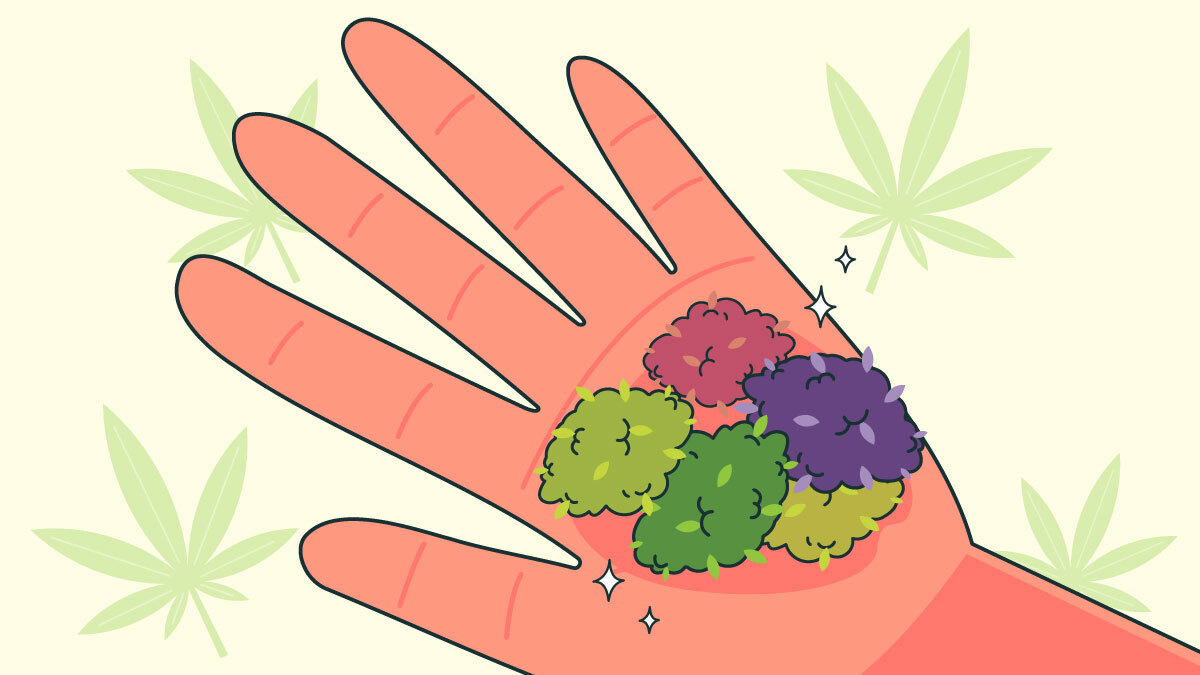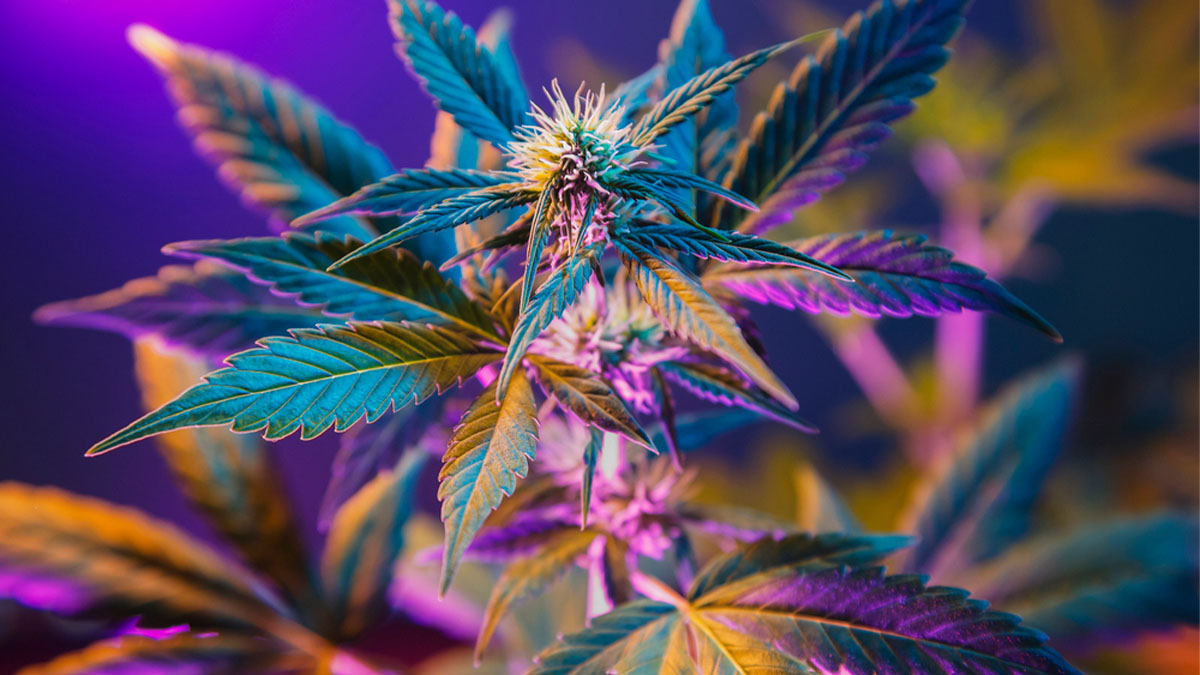Colored Weed: What Causes the Different Colors of Marijuana?

You’re in the produce section of your local supermarket. Some apples are shiny and bright red, others are a dull brownish-orange. Which do you buy?
Naturally, you choose the bright red apples. We naturally associate vibrant colors with fresher, healthier, and tastier fruit.
Now you’re in a dispensary. You see lots of buds that are an ordinary green color. But several other strains grab your attention because of their vibrant orange, purple and red hues. Which do you buy?
Be honest; you’d be tempted to choose the colored weed simply because of its beautiful appearance.
You could be making the right choice, but it would be by accident. There’s no guarantee that the red or purple flower will deliver the experience you’re after.
And there’s a good chance it won’t be more potent than “ordinary” green weed.
Let’s explore.
What Causes Colors in Weed?
Sure, the marijuana plant produces psychoactive cannabis. But first and foremost, it’s a plant — and that means it’s filled with chlorophyll.
You probably remember from grade-school science class that chlorophyll is the pigment that gives plants their green color. It’s crucial for photosynthesis, the process by which plants absorb light and turn it into energy.
Plants don’t always stay green, though. The best examples are the leaves on deciduous trees.
Those leaves are usually green from spring until early fall, when they turn color and create the gorgeous foliage that signals the coming of winter. The green color contributed by chlorophyll is dominant throughout the growing season.
Here’s what’s behind that autumn color change.
When there’s less sunlight and temperatures fall, two things happen to trees. Their leaves’ production of chlorophyll slows, and their existing chlorophyll breaks down. As a result, there’s less green color in the leaves — and that allows other pigments in the leaves to finally be seen.
The same thing happens to many cannabis plants. The buds are green when they emerge, but some strains “change color” during the last part of the flowering stage. That’s because they get less light, the temperatures drop, and the weed plant’s chlorophyll levels drop.
But why do different strains turn purple, while others turn red, orange, or yellow? Credit goes to the same compound that causes leaves to display vibrant colors in the fall.
Meet Anthocyanins
Anthocyanins are the pigments you didn’t learn about during that grade school lesson on chlorophyll.
They belong to a class of compounds called flavonoids, which are found in most plants. All flavonoids provide a number of health and wellness benefits; they’re one of the primary reasons fruits and vegetables are good for you.
Anthocyanins are particularly good for you. They’re antioxidants, helping the body fight the damage done by free radicals. They’re antimicrobials that help fight bacteria and fungi, and they’re anti-inflammatories that can help battle inflammatory diseases. They’re good for the brain, good for the heart, and may even fight some types of cancer.
That’s not all they do. Anthocyanins are also the natural pigments that make blueberries blue, strawberries red, and some grapes purple. And when tree leaves lose their chlorophyll, anthocyanins provide the brilliant colors that mark the fall season.
You probably won’t be surprised to learn that many strains of weed contain anthocyanins. After all, most articles about cannabis mention that it contains flavonoids in addition to cannabinoids and terpenes — and anthocyanins are one of the flavonoids commonly found in marijuana plants.
Strains like Purple Urkle, Blue Haze, and Orange Crush get their trademark colors from the same anthocyanins. But why aren’t they all the same color? It has to do with a chemical reaction.
Anthocyanins and Acidity
Here’s another term you might remember from science class: pH.
It actually stands for “potential of hydrogen,” but most of us understand it as a 0-14 scale that measures how acidic a solution is. As the pH level of a substance gets closer to zero, the more acidity it contains; the higher it climbs above the neutral midpoint of seven, the more alkaline it is.
Believe it or not, pH is what determines the color of colored weed.
Very acidic conditions make anthocyanins look red or pink. As the pH approaches neutral, the flavonoids appear orange. With a pH around the midpoint of seven, purple becomes predominant. Alkaline conditions, on the other hand, make anthocyanins look yellow or blue.
In the fall, when the chlorophyll levels in weed plants become low, the color of the anthocyanins can become obvious. The vibrancy of the color depends on the amount of anthocyanins in the plant, which is primarily a function of genetics.
It would seem that a grower has no control over the color of weed, but that’s not exactly true.
Growing Colored Weed

Cultivators aren’t completely at the mercy of nature if they want to grow colored weed or bring out more of its natural hue. Many growers do just that, for a very good reason.
Purple, red, or black flower isn’t necessarily stronger than green bud. It’s just a different color. Potency depends on the strain, growing conditions, and other unrelated factors, not aesthetic characteristics like color.
However, many buyers incorrectly believe that color directly relates to potency, so purple or red weed is more in demand — and will bring a higher price. That’s led cultivators to cross-breed strains to create strong, colored cannabis buds.
Commercial growers also use several methods to bring out their plants’ colors or even alter them.
pH Changes
Marijuana plants grow best when the soil has a pH level between 5.5 and 6.5. However, altering the pH of the soil can bring out specific colors.
Temperature Regulation
Some strains only show their natural colors when they’re grown in very specific temperatures. Those details are different for each type of weed.
For example, some purple strains only turn purple if the nighttime temperatures dip below 50ºF, and some of the pink strains only turn pink in hotter temperatures.
Light Exposure
Specific levels of light can force plants to produce higher amounts of anthocyanins, making their color more vibrant. This can be tricky, though; too much light can do serious damage to plants.
Nutrient Deficiencies
Depriving some plants of phosphorous may bring out purple or red colors in their buds, and a lack of nitrogen can destroy chlorophyll and bring out the flower’s color earlier in the growth cycle. Only experienced growers should try this because it’s more likely to simply kill the plants.
The best approach for a buyer? Choose a strain for its effects, flavor, and aroma. Color is simply a cool bonus.
Colored Weed FAQ
Q: Are anthocyanins the only flavonoids that determine the color of weed?
A: No, they’re just the ones most commonly responsible, and the ones that create the most vivid colors. Other flavonoids like carotenoids, for example, may cause the weed to be yellow or orange.
Q: What about black weed? Aren’t strains like Black Widow the strongest?
A: They’re often the most potent you can find, but that’s not specifically because of their color. Black bud comes from Vietnamese strains known as landraces, which aren’t cross-bred and have evolved to be extremely potent. They also happen to produce black weed, but the color isn’t what makes these strains powerful. It’s simply the characteristic color of landraces.
References
- Khoo, H. E., Azlan, A., Tang, S. T., & Lim, S. M. (2017). Anthocyanidins and anthocyanins: colored pigments as food, pharmaceutical ingredients, and the potential health benefits. Food & nutrition research, 61(1), 1361779. [1]
- Ogston, A. G. (1947). The definition and meaning of pH. Physiological Reviews, 27(2), 228-239.